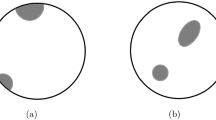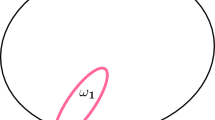Abstract
In this paper, we study the direct/indirect stability of locally coupled wave equations with local Kelvin-Voigt dampings/damping, where we assume that the supports of the dampings and the coupling coefficients are disjoint. First, we prove the well-posedness, strong stability, and polynomial stability for some one dimensional coupled systems. Moreover, under some geometric control conditions, we prove the well-posedness and strong stability in the multi-dimensional case.




Similar content being viewed by others
References
Abdallah F, Ghader M, Wehbe A (2018) Stability results of a distributed problem involving Bresse system with history and/or Cattaneo law under fully Dirichlet or mixed boundary conditions. Math Methods Appl Sci 41(5):1876–1907
Akil M, Chitour Y, Ghader M, Wehbe A (2020) Stability and exact controllability of a Timoshenko system with only one fractional damping on the boundary. Asymptot Anal 119(221–280):3–4
Akil M, Badawi H, Nicaise S, Wehbe A (2021) On the stability of Bresse system with one discontinuous local internal Kelvin-Voigt damping on the axial force. Zeitschrift für angewandte Mathematik und Physik 72(3):126
Akil M, Badawi H, Nicaise S, Wehbe A (2021) Stability results of coupled wave models with locally memory in a past history framework via nonsmooth coefficients on the interface. Math Methods Appl Sci 44(8):6950–6981
Akil M, Badawi H, Wehbe A (2021) Stability results of a singular local interaction elastic/viscoelastic coupled wave equations with time delay. Commun Pure & Appl Anal 20(9):2991–3028
Akil M, Badawi H (2022) The influence of the physical coefficients of a Bresse system with one singular local viscous damping in the longitudinal displacement on its stabilization. Evol Equ & Control Theo
Akil M, Issa I, Wehbe A (2022) A n-dimensional elastic\(\backslash \)viscoelastic transmission problem with kelvinvoigt damping and non smooth coefficient at the interface. SeMA J
Alabau-Boussouira F, Léautaud M (2013) Indirect controllability of locally coupled wave-type systems and applications. J Math Pures Appl (9) 99(5):544–576
Arendt W, Batty CJK (1988) Tauberian theorems and stability of one-parameter semigroups. Trans Amer Math Soc 306(2):837–852
Bassam M, Mercier D, Nicaise S, Wehbe A (2015) Polynomial stability of the Timoshenko system by one boundary damping. J Math Anal Appl 425(2):1177–1203
Batty CJK, Duyckaerts T (2008) Non-uniform stability for bounded semi-groups on Banach spaces. J Evol Equ 8(4):765–780
Borichev A, Tomilov Y (2010) Optimal polynomial decay of functions and operator semigroups. Math Ann 347(2):455–478
Burq N, Sun C (2022) Decay rates for Kelvin-Voigt damped wave equations II: The geometric control condition. Proc Amer Math Soc 150(3):1021–1039
Fatori LH, Monteiro RN (2012) The optimal decay rate for a weak dissipative Bresse system. Appl Math Lett 25(3):600–604
Fatori LH, Monteiro RN, Sare HDF (2014) The Timoshenko system with history and Cattaneo law. Appl Math Comput 228:128–140
Gerbi S, Kassem C, Mortada A, Wehbe A (2021) Exact controllability and stabilization of locally coupled wave equations: theoretical results. Z Anal Anwend 40(1):67–96
Ghader M, Nasser R, Wehbe A (2020) Optimal polynomial stability of a string with locally distributed kelvin-voigt damping and nonsmooth coefficient at the interface. Math Methods Appl Sci 44(2):2096–2110
Ghader M, Nasser R, Wehbe A (2021) Stability results for an elastic-viscoelastic wave equation with localized kelvin-voigt damping and with an internal or boundary time delay. Asympt Anal 125(1–2):1–57
Hayek A, Nicaise S, Salloum Z, Wehbe A (2020) A transmission problem of a system of weakly coupled wave equations with Kelvin-Voigt dampings and non-smooth coefficient at the interface. SeMA J 77(3):305–338
Kassem C, Mortada A, Toufayli L, Wehbe A (2019) Local indirect stabilization of N-d system of two coupled wave equations under geometric conditions. C R Math Acad Sci Paris 357(6):494–512
Kato T (1995) Perturbation Theory for Linear Operators. Springer, Berlin Heidelberg
Liu Z, Rao B (2005) Characterization of polynomial decay rate for the solution of linear evolution equation. Z Angew Math Phys 56(4):630–644
Liu K, Rao B (2006) Exponential stability for the wave equations with local Kelvin-Voigt damping. Z Angew Math Phys 57(3):419–432
Pazy A (1983) Semigroups of linear operators and applications to partial differential equations, volume 44 of Applied Mathematical Sciences. Springer-Verlag, New York
Tebou L (2016) Stabilization of some elastodynamic systems with localized Kelvin-Voigt damping. Discrete Contin Dyn Syst 36(12):7117–7136
Wehbe A, Issa I, Akil M (2021) Stability results of an elastic/viscoelastic transmission problem of locally coupled waves with non smooth coefficients. Acta Appl Math 171(1):23
Wehbe A, Ghader M (2021) A transmission problem for the timoshenko system with one local kelvin-voigt damping and non-smooth coefficient at the interface. Comput Appl Math 40(8):1–46
Author information
Authors and Affiliations
Corresponding author
Additional information
Communicated by Carlos Conca.
Publisher's Note
Springer Nature remains neutral with regard to jurisdictional claims in published maps and institutional affiliations.
Appendix A. Some notions and stability theorems
Appendix A. Some notions and stability theorems
In order to make this paper more self-contained, we recall in this short appendix some notions and stability results used in this work.
Definition A.1
Assume that A is the generator of \(C_0-\)semigroup of contractions \(\left( e^{tA}\right) _{t\ge 0}\) on a Hilbert space H. The \(C_0-\)semigroup \(\left( e^{tA}\right) _{t\ge 0}\) is said to be
-
(1)
Strongly stable if
$$\begin{aligned} \lim _{t\rightarrow +\infty } \Vert e^{tA}x_0\Vert _H=0,\quad \forall \, x_0\in H. \end{aligned}$$ -
(2)
Exponentially (or uniformly) stable if there exists two positive constants M and \(\varepsilon \) such that
$$\begin{aligned} \Vert e^{tA}x_0\Vert _{H}\le Me^{-\varepsilon t}\Vert x_0\Vert _{H},\quad \forall \, t>0,\ \forall \, x_0\in H. \end{aligned}$$ -
(3)
Polynomially stable if there exists two positive constants C and \(\alpha \) such that
$$\begin{aligned} \Vert e^{tA}x_0\Vert _{H}\le Ct^{-\alpha }\Vert x_0\Vert _{H},\quad \forall \, t>0,\ \forall \, x_0\in D(A). \end{aligned}$$\(\square \)
To show the strong stability of the \(C_0\)-semigroup \(\left( e^{tA}\right) _{t\ge 0}\) we rely on the following result due to Arendt and Batty (1988):
Theorem A.2
Assume that A is the generator of a C\(_0-\)semigroup of contractions \(\left( e^{tA}\right) _{t\ge 0}\) on a Hilbert space H. If A has no pure imaginary eigenvalues and \(\sigma \left( A\right) \cap i{\mathbb {R}}\) is countable, where \(\sigma \left( A\right) \) denotes the spectrum of A, then the \(C_0\)-semigroup \(\left( e^{tA}\right) _{t\ge 0}\) is strongly stable. \(\square \)
Concerning the characterization of polynomial stability stability of a \(C_0-\)semigroup of contraction \(\left( e^{tA}\right) _{t\ge 0}\) we rely on the following result due to Borichev and Tomilov (2010) (see also Batty and Duyckaerts 2008 and Liu and Rao 2005):
Theorem A.3
Assume that A is the generator of a strongly continuous semigroup of contractions \(\left( e^{tA}\right) _{t\ge 0}\) on \({\mathcal {H}}\). If \( i{\mathbb {R}}\subset \rho (A)\), then for a fixed \(\ell >0\) the following conditions are equivalent:
\(\square \)
Rights and permissions
About this article
Cite this article
Akil, M., Badawi, H. & Nicaise, S. Stability results of locally coupled wave equations with local Kelvin-Voigt damping: Cases when the supports of damping and coupling coefficients are disjoint. Comp. Appl. Math. 41, 240 (2022). https://doi.org/10.1007/s40314-022-01956-6
Received:
Revised:
Accepted:
Published:
DOI: https://doi.org/10.1007/s40314-022-01956-6




